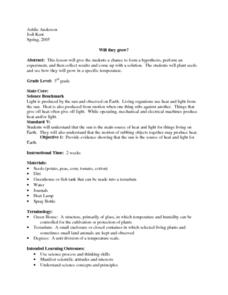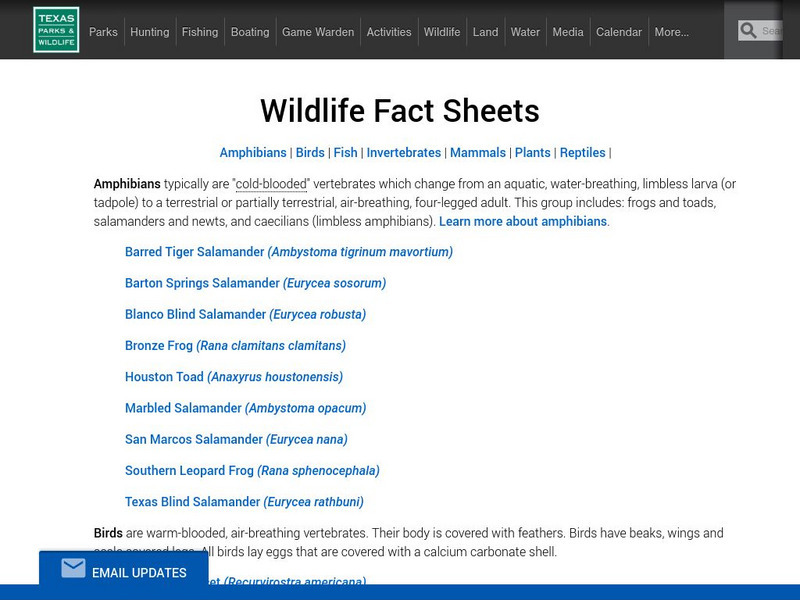Curated OER
Philadelphia's Important Contribution to the Lewis and Clark Expedition
Students analyze a primary source document (Jefferson's secret letter to Congress) and identify its objectives through the aid of focus questions. They complete a graphic organizer and write an article summarizing Philadelphia's...
Curated OER
Xinjiang: A Bi-Cultural Perspective
Twelfth graders research the affects the Chinese Nuclear Program has had on the environment and the health of the Uighur minority.
Curated OER
Oh, California: Understanding Primary Sources: What Did John Muir See?
Students read a selection from the writings of John Muir. They discover his view on California and its natural resources. They create a display of images that show what California has to offer.
Curated OER
Will they grow?
Third graders plant seeds and see how they will grow in a specific temperature and are questioned about different environments and how they think crops would grow there. They form a hypothesis, perform an experiment, and then collect...
Curated OER
What Is A Dinosaur?
Students use the question of "What is a dinosaur?" in order to establish the context for a class investigation. They use a variety of resources in order to gather information. Students compare and contrast the similarities or differences...
Curated OER
Antarctica Food Chain
Students visit an interactive web page. In this food chain lesson, students visit an interactive web page displaying an example of the food chain in Antarctica. As students move their mouse over the images, captions appear describing the...
Ducksters
Ducksters: Animals for Kids: Animal Migrations
Kids learn about Animal Migrations. How animals travel for miles across the land, air, and sea for the changing seasons.
TED Talks
Ted: Ted Ed: How Life Came to Land
This video explores arthropods, who first made the transition from water to land and who outnumber all terrestrial animals. [5:28] Followed by a short quiz and a list of additional resources to explore.
Exploratorium
Exploratorium: The Amazing Adaptable Frog
Journey back over a million years ago and see how the common frog has adapted and changed.
Texas Parks and Wildlife
Texas Parks & Wildlife Department: Wildlife
Here you will find a description of many types of wildlife species living in Texas. Clicking on the underlined words will direct you to links to related topics. Browse through the website (land and water) to discover aquatic species and...
Globio
Glossopedia: Seals
Seals are mammals that live parts of their lives on land and other parts entirely in the water. They breed and care for their babies on land, but spend most of their lives in the ocean. This article provides an in-depth look at these...
US Geological Survey
U.s. Geological Survey: The Usgs and Science Education
"Explore things on, in, around and about the earth," with this web site dedicated to K-12 education from the United States Geological Survey. Homework help, science topics and fun learning games for students in Kindergarten through High...
E-learning for Kids
E Learning for Kids: Science: Greece: What Is the Earth Made Of?
Dionysus is a Greek God. and a theater director. Help him get ready for the play and learn about land, water, and air. After completing this lesson, students should be able to identify the different materials Earth is made up from (land,...
Other
Ocean Oasis: Field Guide
Ocean Oasis is a giant-screen film that depicts Mexico's Sea of Cortes and the Baja California desert. This companion site features much of the information the film has, such as beautiful images of animals, water, and land that have...
Other
Caribbean Beat: The Unexpected Country
Interesting article describing the unique setting and characteristics of Guyana. Read about this "Land of many waters," and understand what makes Guyana so special.
Environmental Education for Kids
Eek!: Amphibians
Amphibians are cold-blooded, smooth-skinned vertebrates. Most live some of their life in water and some on land. The most common amphibian critter is a frog but there are many others. Read about Wisconsin's many amphibians here.
TED Talks
Ted: Ted Ed: The Surprising (And Invisible) Signatures of Sea Creatures
On land, animals leave footprints that tell us a lot about their size, form and capabilities. Marine organisms do this too, but these footprints are harder to see since water is translucent. Bioengineer Kakani Katija explains how she...
















